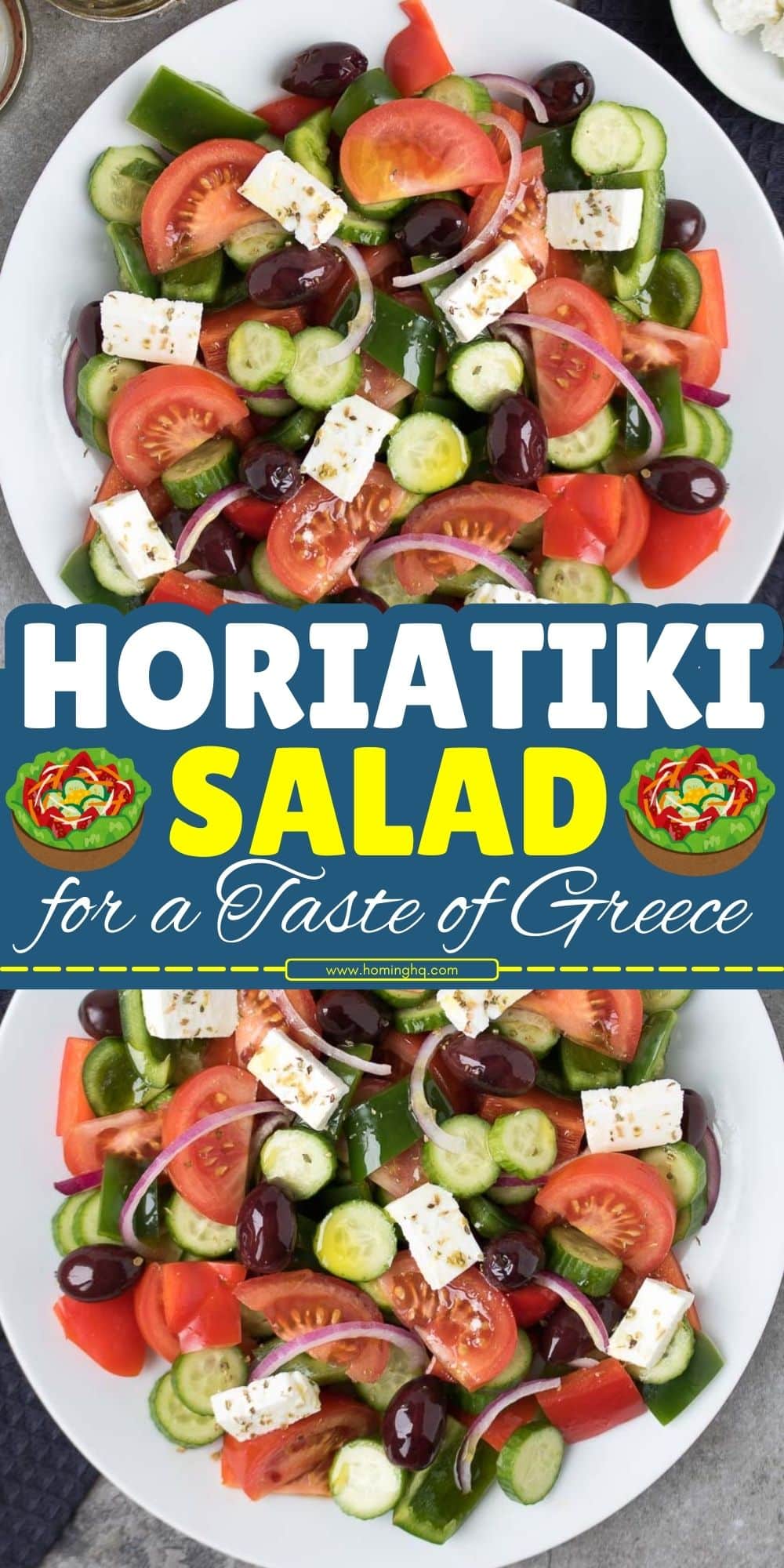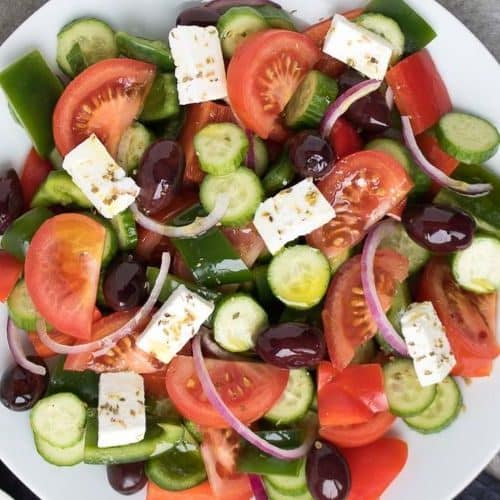All products are selected by our editorial team for quality. If you buy through our links, we may earn a small commission at no extra cost to you.
Horiatiki Salad, often known as Greek Village Salad, is a cornerstone of Greek cuisine.
This salad is celebrated for its simplicity and the freshness of its ingredients.
It embodies the flavors of the Mediterranean, where fresh produce is always the star.
Originating from rural Greece, it captures the essence of Greek culinary traditions.
Unlike other salads that rely on complex dressings or toppings, Horiatiki Salad highlights the quality of its raw ingredients.
Every ingredient in this salad plays an important role.
From the juicy tomatoes to the briny Kalamata olives, each bite is packed with vibrant flavor.
The dressing is minimal, made with just olive oil, vinegar or lemon, and a sprinkle of oregano.
This allows the freshness of the ingredients to truly shine.
Horiatiki Salad is traditionally served as a side dish but can also be enjoyed as a light main course.
It has become popular worldwide, loved for both its taste and its health benefits.
This simple yet delicious dish is a perfect way to bring the flavors of Greece to your table.

Ingredients for Horiatiki Salad
Horiatiki Salad is made from a handful of fresh, wholesome ingredients.
Each ingredient plays a vital role in creating the perfect balance of flavors.
Fresh Tomatoes
Tomatoes are the star of Horiatiki Salad.
They should be ripe and juicy, providing a burst of sweetness and acidity in every bite.
Look for tomatoes that are firm and vibrant in color to ensure they’re at their best.
Cucumbers
Cucumbers are essential for adding a refreshing crunch to the salad.
They should be firm and crisp, with a mild, cool flavor.
Be sure to peel the cucumbers if the skin is tough or waxed, but otherwise, leave the skin on for extra texture.
Red Onions
Red onions add a mild sweetness and a hint of sharpness to the salad.
Slice them thinly to ensure they’re not too overpowering.
They offer a slight bite without detracting from the other ingredients.
Kalamata Olives
Kalamata olives bring a rich, salty flavor to the salad.
Their briny taste perfectly balances the sweetness of the tomatoes and the richness of the feta cheese.
These dark purple olives are a must for an authentic Horiatiki Salad.
Green Bell Peppers
Green bell peppers add a crisp, slightly bitter taste to the mix.
Their texture provides a satisfying crunch, while their mild flavor doesn’t overwhelm the other ingredients.
Feta Cheese
Feta is the iconic cheese in this salad.
It should be used in block form rather than crumbled, allowing it to retain its creamy texture.
The saltiness of the feta complements the vegetables and olives perfectly.
Extra Virgin Olive Oil
The olive oil is the foundation of the salad dressing.
It should be high-quality extra virgin olive oil to provide the best flavor.
This oil brings richness to the salad, coating the vegetables and bringing the flavors together.
Dried Oregano
Dried oregano is a key seasoning in Horiatiki Salad.
Its earthy, aromatic flavor is a perfect match for the fresh vegetables.
A generous sprinkle adds a fragrant note that elevates the entire dish.
Red Wine Vinegar or Lemon Juice
Red wine vinegar or fresh lemon juice adds acidity, balancing the richness of the olive oil and feta.
Both options offer a bright, zesty kick to the salad.
The vinegar or lemon juice helps to highlight the flavors of the vegetables.
Salt and Pepper
Seasoning with salt and freshly cracked black pepper is essential.
The salt enhances the natural flavors of the ingredients, while the pepper adds a touch of heat.
These simple seasonings complete the dressing and bring everything together.
How to Prepare the Vegetables for Horiatiki Salad

The key to a great Horiatiki Salad lies in how you prepare the vegetables.
By cutting and handling the ingredients properly, you preserve their freshness and texture.
Choosing Fresh Vegetables
Start by selecting fresh, in-season vegetables.
Ripe tomatoes with firm skin and vibrant color are essential.
Look for cucumbers that are firm, without any soft spots or blemishes.
Pick red onions that are crisp and free from any signs of wilting.
Green bell peppers should be glossy and fresh, with no wrinkles or spots.
Choosing the freshest ingredients ensures the salad tastes its best.
Cutting the Vegetables
Cut the tomatoes into wedges.
This allows them to hold their shape while releasing just the right amount of juice.
For the cucumbers, slice them into thick half-moons for added crunch.
Don’t slice them too thinly, as you want them to retain their texture.
The red onions should be sliced thinly, but not too thin.
This ensures they add just the right amount of bite without overpowering the other ingredients.
Cut the green bell peppers into thick strips or slices.
These larger pieces provide crunch and help balance the flavors.
Preserving the Ingredients’ Integrity
The key to a traditional Horiatiki Salad is to keep the ingredients rustic and chunky.
Avoid chopping the vegetables too finely, as it will lose the salad’s signature texture.
Mix the vegetables gently so they don’t break apart.
Overmixing can cause the salad to become soggy and lose its fresh appeal.
By preparing the vegetables with care, you ensure that each ingredient shines in the final dish.
The Secret to the Best Dressing for Horiatiki Salad
The dressing for Horiatiki Salad is simple but crucial to bringing all the ingredients together.
Unlike many salads, the dressing is not meant to overpower the fresh vegetables but to enhance their natural flavors.
Olive Oil as the Base
The foundation of the dressing is extra virgin olive oil.
Opt for a high-quality olive oil that has a robust flavor, as it will tie the salad together.
The oil should be poured generously over the vegetables, creating a smooth, rich coating that complements the crisp ingredients.
Acidity: Red Wine Vinegar or Lemon Juice
To balance the richness of the olive oil, an acidic element is needed.
You can choose between red wine vinegar or fresh lemon juice.
Both options add a bright, tangy kick that enhances the overall freshness of the salad.
If you prefer a sharper, more pungent flavor, red wine vinegar is the way to go.
On the other hand, lemon juice offers a fresher, citrusy note that pairs beautifully with the vegetables.
Seasoning with Oregano, Salt, and Pepper
The dressing is completed with a pinch of dried oregano.
This Mediterranean herb adds an earthy, aromatic flavor that is essential to an authentic Horiatiki Salad.
Season the dressing with salt and freshly cracked black pepper.
These simple seasonings are enough to bring all the ingredients into harmony.
It’s important not to overmix the dressing.
Just drizzle it over the salad and toss gently to coat the vegetables.
This way, the flavors stay fresh, and the vegetables maintain their crispness.
Variations and Customizations of Horiatiki Salad
While the traditional Horiatiki Salad is delicious on its own, there are several ways you can customize it to suit your taste.
Vegan and Dairy-Free Options
If you’re following a vegan or dairy-free diet, you can easily adjust the salad.
Instead of feta cheese, try using plant-based feta or simply omit the cheese.
You can also add avocado for a creamy texture that complements the fresh vegetables.
Adding Protein to Make It a Full Meal
For those who want to make Horiatiki Salad a more substantial dish, adding protein is a great option.
Grilled chicken, lamb, or seafood like shrimp or grilled fish work wonderfully with the salad.
Simply add the cooked protein on top or serve it alongside the salad for a more filling meal.
Adding Extra Vegetables
Feel free to get creative with the vegetables.
Though the traditional recipe is simple, you can incorporate other Mediterranean vegetables.
Chopped cucumbers, radishes, or even artichoke hearts can be added for more texture and flavor.
You could also try adding fresh herbs like parsley, basil, or mint to add a fresh, green note to the salad.
Spice It Up
For those who enjoy a bit of heat, a dash of crushed red pepper flakes can be added to the dressing.
This brings a touch of spiciness without overpowering the freshness of the salad.
Alternatively, a few slices of fresh chili peppers can be added directly to the salad for an extra kick.
Experimenting with Dressings
While the traditional olive oil and vinegar dressing is classic, you can experiment with other flavors.
Try adding a teaspoon of Dijon mustard to the dressing for a subtle tang.
A small drizzle of honey can also add a touch of sweetness, balancing the salty feta and briny olives.
Feel free to experiment with different variations, but always keep the essence of Horiatiki Salad intact.
Fresh, seasonal vegetables, a few simple seasonings, and high-quality ingredients will always make this salad a winner.
How to Serve Horiatiki Salad
Horiatiki Salad is a versatile dish that can be served in various ways, depending on the occasion.
As a Side Dish
The most traditional way to serve Horiatiki Salad is as a side dish.
It pairs perfectly with grilled meats, seafood, or even as a complement to a hearty Mediterranean meal.
The fresh, crisp ingredients balance out the richness of grilled lamb, chicken, or fish, making it a refreshing accompaniment.
As a Light Main Course
On its own, Horiatiki Salad can also serve as a satisfying light meal.
The feta cheese and olives provide enough richness, while the fresh vegetables keep it light and healthy.
If you’re looking for a lighter lunch or dinner, serve it with a few slices of crusty bread or pita on the side to scoop up the dressing.
Pairing with Other Greek Dishes
Horiatiki Salad is a fantastic addition to a full Greek feast.
Serve it alongside other traditional dishes like tzatziki, hummus, spanakopita (spinach pie), or grilled kebabs.
For a truly Mediterranean experience, accompany the meal with a glass of crisp white wine or refreshing iced tea.
For Special Occasions
If you’re hosting a Mediterranean-inspired dinner or a casual gathering, Horiatiki Salad makes for a vibrant centerpiece.
Its colorful vegetables and simple beauty will impress guests.
Consider serving it in a rustic, large bowl for an authentic presentation.
Conclusion
Horiatiki Salad is the perfect example of how simple ingredients can create a truly unforgettable dish.
Its fresh vegetables, tangy dressing, and creamy feta combine to offer a burst of Mediterranean flavor in every bite.
Whether you’re enjoying it as a light meal or a refreshing side, it’s a versatile salad that can be customized to your liking.
Its health benefits, thanks to the fresh ingredients and olive oil, make it an excellent choice for those seeking both flavor and nutrition.
There’s no wrong way to enjoy this salad, and it’s sure to be a crowd-pleaser no matter how you serve it.
With its authentic taste and vibrant colors, Horiatiki Salad brings the flavors of Greece straight to your table.
Frequently Asked Questions
1. Can I make Horiatiki Salad ahead of time?
Yes, you can prepare Horiatiki Salad ahead of time, but it’s best to add the dressing just before serving to keep the vegetables crisp.
You can cut the vegetables and store them separately in the fridge for up to a day before assembling.
2. Can I substitute other cheeses for feta in Horiatiki Salad?
Yes, you can try using goat cheese or ricotta salata as alternatives to feta.
However, for the authentic flavor, traditional block-style feta is highly recommended.
3. How long can I store leftovers of Horiatiki Salad?
Leftover Horiatiki Salad can be stored in an airtight container in the fridge for up to 1-2 days.
However, the salad may lose its crispness and the dressing might soften the vegetables over time.
4. Can I add other vegetables to the salad?
Absolutely! While the traditional version includes tomatoes, cucumbers, onions, and peppers, feel free to experiment.
Add extra vegetables like radishes, olives, or even artichoke hearts for a unique twist.
5. What can I serve with Horiatiki Salad?
Horiatiki Salad pairs wonderfully with grilled meats, seafood, or Mediterranean dishes like tzatziki, hummus, and pita.
It can also be enjoyed with a side of crusty bread or as part of a mezze platter.

Horiatiki Salad
Equipment
- 1 Large Salad Bowl
- 1 Sharp knife
- 1 Cutting Board
- 1 Measuring Spoon (for oregano, salt, and pepper)
- 1 Salad Tongs or Wooden Spoon (for mixing)
Ingredients
- 4 large Tomatoes cut into wedges
- 1 large Cucumber sliced into half-moons
- 1 small Red Onion thinly sliced
- 1 cup Kalamata Olives about 20 olives
- 1 Green Bell Pepper sliced into strips
- 200 g Feta Cheese cut into large blocks
- 1/4 cup Extra Virgin Olive Oil
- 1 tablespoon Red Wine Vinegar or Lemon Juice
- 1 teaspoon Dried Oregano
- Salt to taste
- Freshly cracked Black Pepper to taste
Instructions
- Prepare the vegetables: Cut the tomatoes into wedges, slice the cucumber into half-moons, and thinly slice the red onion and green bell pepper.
- In a large salad bowl, combine the tomatoes, cucumber, red onion, green bell pepper, and Kalamata olives.
- Place the blocks of feta cheese on top of the salad.
- Drizzle the olive oil and red wine vinegar (or lemon juice) over the salad.
- Sprinkle the oregano, salt, and freshly cracked black pepper on top.
- Gently toss the ingredients together, making sure to keep the vegetables intact and not to break the feta cheese blocks.
- Serve immediately, or store the salad without the dressing for later use.
Notes
- Feta: Use block-style feta for the most authentic texture and flavor. If you use crumbled feta, the salad will not have the same traditional appearance.
- Vinegar or Lemon: You can choose either red wine vinegar or fresh lemon juice, but lemon juice will provide a brighter, fresher flavor.
- Vegetable Variations: Feel free to add extra vegetables like radishes, artichokes, or olives for a unique twist.
- Storing: If you have leftovers, store the salad in an airtight container without the dressing. It will keep for up to 1-2 days. Add the dressing just before serving for the best results.
- Vegan Option: Omit the feta cheese or substitute it with plant-based feta for a vegan version of the salad.

